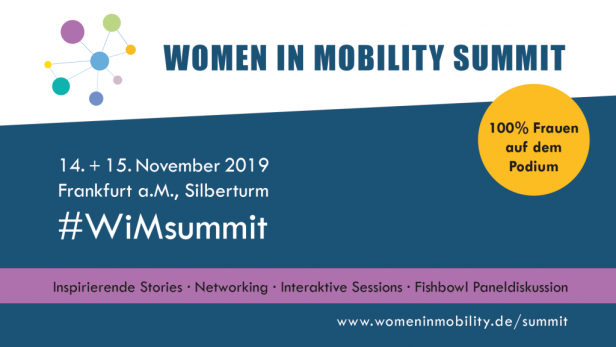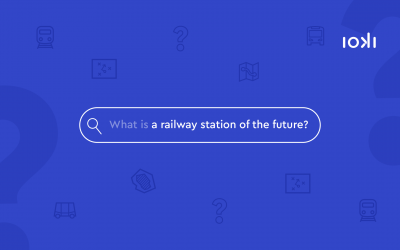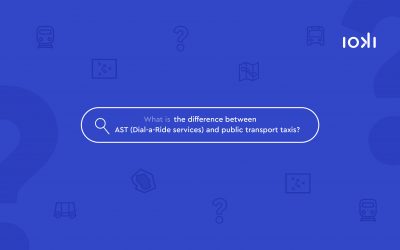Just in time for the Women in Mobility Summit we had the opportunity to talk to the three initiators Sophia von Berg, Coco Heger-Mehnert and Anke Erpenbeck (from left to right).
Ms von Berg, Ms Heger-Mehnert and Ms Erpenbeck, you have learned a lot from the world of mobility during your career. Where did your interest in working in the mobility industry come from? What makes it so fascinating?
Anke Erpenbeck: I have been working for 10 years in the marketing department of Kölner Verkehrs-Betriebe. At the time, I didn’t consciously decide for the industry, but rather for the job. But the mobility industry really gripped me: At the moment I hardly know of any other industry in which so much is happening. Being able to help shape these changes is a great attraction for me. Public transport plays an important role in the efforts to make mobility sustainable. I am happy that I can make my contribution to positioning KVB as THE mobility service provider for Cologne.
Coco Heger-Mehnert: I have been working for Verkehrsverbund Rhein-Ruhr for 15 years. Associations play an important hinge role between politics and transport companies. As with Anke, I did not consciously switch to this industry and at the beginning I still had doubts as to whether it suited me. What binds me to this industry today is the thought of working on something very relevant for society. Today, mobility is one of the most important levers in terms of climate change. For me, this also goes hand in hand with the issue of digitization. Fathoming out how this communication, information, access and pricing can be optimised for public transport is an extremely exciting task.
Sophia von Berg: During my studies, I worked for an automobile manufacturer and managed the “CO2 label for passenger cars” project. I quickly realized that the colored bars that everyone knows about their refrigerators had little meaning about the CO2 efficiency of cars. That didn’t let go of me and so I also dealt scientifically with traffic and sustainability. The variety of means of transport and mobility services still fascinates me today. I am driven by the question of how we can use this space of opportunity to create solutions for sustainable mobility.
With your network you want to strengthen women, no matter from which branch of the mobility industry, therefore we are interested in: How did the whole thing actually start? Where does the idea come from and where do you see the thematic focus of your network? Why is such a network so important?
Sophia: It all started at a conference on multimodality. I was really annoyed that almost only men were present – both on the podium and in the audience. During the breaks I talked to the few women and that was so inspiring! Everyone worked on exciting topics, but none of them was ever asked if they wanted to present them at a conference. We agreed that there should be more opportunities for exchange among women. And so the idea for the network was born.
Coco: Yes, Sophia and I already knew each other from some mobility events and when we talked about the network idea we quickly agreed: we wanted to tackle it. Since I already knew Anke from the traffic camp and knew how proactive she was, I approached her directly. In June 2015, the three of us met in Düsseldorf to define the first framework conditions. It was important to us that it should be a network for women from all sectors of the mobility industry, because only by linking the sectors and exchanging ideas can we work towards making mobility more sustainable and giving the cities back to the people.
Can you explain to us what strategy you are pursuing to promote women more in an industry that has hitherto been more “male-oriented”? How could the area of transport & logistics be made more attractive for women?
Sophia: Of course, there is a special focus on the visibility of women – by empowering women, e.g. through speaker placements, by showing how many inspiring and professionally experienced women there are in the mobility industry, we can help to fill the podiums at events more diversely and to put women in the focus of job placements – especially in management positions.
Anke: The mobility industry currently has a share of 20-30% women – depending on which sector you are in. Public transport, for example, is very male-dominated, especially in the technical areas. On the one hand, this is due to the fact that far fewer girls opt for a technical service when choosing their career. In my opinion, this is due very much to the role models with which the children grow up. When do you see a woman on a construction site, programming on a computer or welding metal in children’s books? The role models are often missing, the girls and young women show that such professions are just as suitable for them as the classic “women’s professions” such as nurse or educator. Therefore we try to make women more visible through our events and our communication in the social networks and to show everyone that the mobility industry is a great industry in which women can find an exciting job as well as make a career.
Coco: At the moment, the mobility industry is still very technical – when you think of cars or trains, you mainly think of men who design, build or drive them. In addition to the increased training of women in technical professions, the design of mobility today requires a variety of other skills that women can contribute. These include, for example, knowledge of transport mode choice behaviour, shaping access to mobility services, defining requirements also for living spaces in cities and mobility concepts derived from these, etc. In addition, the conditions in companies must be suitable for different phases of life. Not only for women, but also for men: job sharing, part-time management, company kindergartens, home offices, etc. are needed.
In addition to a digital exchange, they also offer networking events and have founded hubs in Berlin, Hamburg, Cologne, Munich, Nuremberg and Bern. You will also be hosting the Women in Mobility Summit in Frankfurt am Main on 14 and 15 November, which is a mix of a specialist conference and the interactive elements of a bar camp. Is Germany actually unique with such a network and events for women in mobility or are they planning to expand the network abroad – or in Frankfurt?
Sophia: We are certainly not unique – there are already many mobility networks for women. In Germany and Europe, however, these are usually focused on one mobility sector. In any case, we have developed a unique concept for the WiM Summit, because only women who have an exciting story to tell are on stage. There will be no pure specialist lectures at the Summit; the women from different professions will describe their perspectives on the world of mobility. For example, Maria Vassilakou, former Deputy Mayor of Vienna, will talk about what it feels like to be one of the most hated people in Vienna because she has pushed back car traffic in the Austrian capital and massively promoted public transport and cycling.
Coco: An expansion of the network is planned in any case – a hub is currently being set up in Stuttgart and we are already talking to interested women in Frankfurt and London. However, since we are completely volunteering to look after the network, we are also interested in slow, organic growth.

On-demand shuttles, electric scooters and autonomous vehicles – new mobility has now also reached Germany. What do you think about these changes and how can transport companies manage to digitise their products and adapt them to the new developments?
Anke: Above all, this requires the right employees; people who are open to new things, who sometimes question proven things, who try, test and sometimes fail. It is important, however, that a culture of error is established in the companies, so it is okay that things get in the pants at times – if you learn from it and also apply the lessons learned in the next project. Communication is also very important, because digitalization causes great anxiety among many employees. Things change faster and faster and many are afraid to fall by the wayside. To take these fears away from employees, to prepare them for the fact that new things also offer great opportunities, that’s the big board that companies have to drill.
Sophia: Change opens up opportunities. But not in direct transfer to the street, but first in the head. The shares in the modal split for car sharing and other mobility services are infinitesimally small; the study situation on the traffic impact of new services is rather sobering. Nevertheless, we are seeing a lively discussion in the press and in our own social environment, initial expressions of interest or even true waves of enthusiasm with regard to the new mobility offers. Sometimes this is followed by a reflection on one’s own mobility routines and sometimes even a timid rethinking. This thematic omnipresence can be used by policy-makers and decision-makers to enforce even inconvenient measures. For a real turnaround with a traffic effect means on the one hand the massive promotion of sustainable mobility (public transport, cycling, pedestrian traffic) and on the other hand noticeable cuts in the mobility routines of many people who today use the private car for all routes – also in urban areas. The complementary diversity of new mobility offers makes sense especially when people are dependent on them.
And finally, a question on mobility: How do you see the future of mobility? What will change and what would you wish for, what will change?
Anke: Above all, I want the cities to belong to the people again. At the moment, everything is geared towards the car. For example, I think this super-block principle, which is practised in Barcelona, is a good idea. Nine blocks of houses are usually combined to form a so-called superblock. Local residents and suppliers can drive into a super block, but the rest of the traffic is routed around the blocks on larger roads. The areas that have become vacant, such as the former intersections, have been converted into playgrounds or football pitches. Instead of large roads, bicycle paths and footpaths have been built on the super blocks. This makes it easier for local residents to do without their own car.
Politicians are also called upon to take action. A departure from autocentric transport policy is more than necessary in the context of the current climate debate. Above all in the cities, more must be invested in public transport and bicycle infrastructure. Of course, this will mean cuts for motorists. But the cities are on the verge of traffic collapse, and a rethink is urgently needed. Cities such as Copenhagen, Vienna and Amsterdam are successfully leading the way. Nobody really needs a car in a big city. Often it is comfort or years of habituation that make people get into a car. Why do you have to drive the 800 m to the bakery by car? Or drop off your own children at school in an SUV? Of course, things look different in rural areas. It is difficult to do without a car there. But digitalisation will also help here. On-demand traffic in autonomous vehicles is still a dream of the future today, but why shouldn’t people be picked up by an autonomous vehicle in 10 or 20 years’ time in rural areas that collects two or three passengers on the way to their destination? Many people are currently simply driving cars because, for example, they don’t get to work by public transport. But I dare to doubt that the majority of people really want to sit behind the wheel themselves.
Coco: In addition to the ideas Anke has already expressed, I would also like to see a new way of thinking about how urban space can be designed in such a way that it can be given back to the citizens. In addition, it is conceivable that the trend towards urbanisation due to the burden placed on cities by climate change will also be reversed and that secondary centres and rural space will regain a completely different significance. Therefore, such developments must be taken into account when designing mobility concepts. My most urgent wish is a long-term vision for the design of mobility that is supported by everyone and is not repeatedly called into question by party-political intrigues and upcoming elections. The situation requires a clear orientation towards expert advice, greater citizen participation and a regulatory policy that also gives room to new concepts.
Sophia: Anke and Coco have drawn this vision of the future especially for me. I would like to add one more thing: the future of sustainable, i.e. ecologically compatible, economically efficient and humane mobility is NOW. Discussions about the future must be followed by consistent decisions and binding implementation!
Photo: © Angelika Zinzow www.angelikazinzow.de



